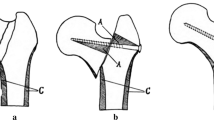Abstract
In the last part of the nineteenth century and beginning of the twentieth century surgeons at the University of Vienna helped transform the practice of surgery. They developed new more effective procedures, analyzed the results of their operations, promoted the emergence and growth of surgical specialties and sought understanding of tissue structure, physiology and pathophysiology. Their efforts made Vienna one of the world’s most respected centres for operative treatment, basic and clinical research and surgical education. Two individuals, Adolf Lorenz (1854-1946) and Lorenz Böhler (1885-1973) focused their research and clinical practice on orthopaedics. During the same period in Germany Friedrich Pauwels (1885-1980) founded an orthopaedic institute and an engineering workshop in Aachen in 1913 and rapidly developed a lifelong interest in biomechanical influences: Using these theories, he achieved in 1927 healing of a non-union of the femoral neck by a re-orientation osteotomy, a condition considered to be incurable until this osteotomy and created his famous classification of fracture angles at the hip into Pauwels types I, II and III. The German orthopaedist Gerhard Küntscher (1900-1972) remained the most popular surgeon after the second war with his famous nail.


















Similar content being viewed by others
References
Lorenz, A. (1886). Pathologie und Therapie der seitiichen Riuckgratsverkrum-mungen. (Vienna)
Lorenz, A. (1895). Parhologie und Therapie der angeborenen Huftverrenkung auf Grundlage von hundert operativ behandelten Fallen (Vienna and Liepzig)
Lorenz, A. (1896). Dber die Stellung der funktioneIle Methode der Belastung des eingerenkten Schenkelkopfes mit dem Korpergewicht zu den anderen unblutigen Behandlungsmethoden der angeborenen Hiiftverrenkung, Wien klin. Wchschr. 36
Lorenz, A. (1897). Wien klin. Rundschau, 21
Lorenz, A. and Reiner, M. (1905). Die angeborene Huftverrenkung. In Handbuch der Orthopadischen Chirurgische. (Jena)
Lorenz, A. (1920). Die sogenannte angeborene Huftrerrenkung, ihre Pathologie and Therapie. (Stuttgart)
Lorenz A (1936) My life and work: the search for a missing glove. Charles Scribner, New York, p 362
Fatovic-Ferencic S, Pecina M (2014) The Balkan beam - Florschütz frame and its use during the great war. Int Orthop 38(10):2209–2213
Böhler L (1929) Die Technik der Knochenbruchbehandlung, Bd. I, Bd. II, Erg.band.
Böhler L (1931) Diagnosis, pathology and treatment of fractures of the os calcis. J Bone Joint Surg 13:75
Böhler L (1948) Medullary nailing of Küntscher. (London)
Böhler J (1985) “Lorenz Böhler. Der Vater der Unfallchirurgie. (1885-1973). Zentralbl Chir 110(4):194–199
Pauwels F (1935) Der Schenkelhalsbruch ein mechanisches Problem. Stuttgart, Enke
Pauwels F (1965) Gesammelte Abhandlungen zur funktionellen Anatomie des Bewegungsapparates. Springer, Berlin
Pauwels F (1971) Ergebnisse der Anatomie und Entwicklungsgeschichte. Bd.44./H.3. Mechanical stress, functional adaptation and the variation structure of the human femur diaphysis. Springer, Heidelberg
Pauwels F (1973) Atlas zur Biomechanik der gesunden und kranken Hüfte. Springer-Verlag, Berlin
Pauwels F (1980) Biomechanics of the locomotor apparatus. Completely revised and enlarged, incl. seven new chapters. Springer, Berlin
Maquet P (1980) Pauwels obituary. Int Orthop 4:237–238
Küntscher G (1959) Die Technik des Aufweitens der Markhohle. Chirurg 30(1):28
Heim H (1943) Die Marknagelung der langen Rohrenknochen nach Küntscher. Der Deutsche Militararzt 8(3):137
Westerborn A (1944) Nailing of the marrow cavity in cases of recent fractures and pseudarthroses. Acta Chir Scand 90:89
Laurence G (1944) L’enclouage medullaire des fractures des os longs: methode de Küntscher. Rev D Orth et de Chir de l’appareil locomoteur 30:32
Chigot PL (1946) A propos des osteosyntheses diaphysaires intramedullaires. Presse Med 54:89
Küntscher G (1948) Recent advances in the field of medullary nailing. Ann Chir et Gynaec Fenniae 37(2):115–136
Watson-Jones R et al (1950) Medullary nailing of fractures after 50 years. J Bone Joint Surg 32B:694
Hernigou P (2015) Medieval orthopaedic history in Germany: Hieronymus Brunschwig and Hans von Gersdorff. Int Orthop 39:2081–2086. doi:10.1007/s00264-015-2868-6
Hernigou P (2015) Fathers of Orthopedics in Germany (18th century and early 19th century): Lorenz Heister in Helmstedt. Johann Friedrich Dieffenbach at Berlin; Heine’s family at Würzburg. Int Orthop. doi:10.1007/s00264-015-2955-8
Hernigou P (2015) Authorities and foundation of an orthopaedic school in Germany in the nineteenth century: Part I: Conrad Johann Martin Langenbeck; Georg Friedrich Louis Stromeyer; Bernhard Rudolf Conrad von Langenbeck. Johann Friedrich August von Esmarch. Int Orthop (SICOT). doi:10.1007/s00264-015-3009-y
Hernigou P.(2015) Authorities and foundation of the orthopaedic school in Germany in the 19th century: part II: Richard von Volkmann, Julius Wolff, Albert Hoffa, Friedrich Trendelenburg and other German authors Int Orthop.
Author information
Authors and Affiliations
Corresponding author
Electronic supplementary material
Below is the link to the electronic supplementary material.
Rights and permissions
About this article
Cite this article
Hernigou, P. The Vienna and German heritage of orthopaedics from the first half of the twentieth century: Adolf Lorenz, Lorenz Böhler, Friedrich Pauwels, Gerhard Küntscher. International Orthopaedics (SICOT) 40, 1049–1058 (2016). https://doi.org/10.1007/s00264-015-3101-3
Received:
Accepted:
Published:
Issue Date:
DOI: https://doi.org/10.1007/s00264-015-3101-3




